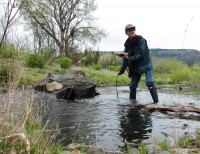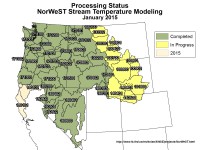Columbia Riverkeeper’s citizen scientist started collecting water quality data on the Columbia River in 2006. By following a strict protocol and quality control procedures our volunteers developed a reputation for producing high-quality data. When the U.S. Forest Service asked us to contribute data for an important regional temperature modeling effort, we were more than happy to share.

The NorWeST regional stream temperature model is an inter-agency database and model coordinated by the U.S. Forest Service. This collaborative effort compiled regional temperature data to create a comprehensive database and climate prediction model for Pacific Northwest streams. The project includes high-resolution historic and future stream climate scenario maps and a powerful online interactive map that will facilitate climate vulnerability assessments, coordination of temperature monitoring, and research on thermal ecology. Riverkeeper citizen scientists are thrilled to provide data for this comprehensive and powerful tool.
Temperature is a pervasive issue facing the Columbia River today and is arguably one of the biggest threats to the survival of steelhead, salmon and other cold-water species. Temperature is a critical factor influencing biological and chemical conditions in the environment. Many species use temperature to regulate the timing of reproduction and migration, but the Columbia River is simply too warm. Scientists determined that salmon survival requires cool water: the temperature must remain below 68°F, and this is the maximum temperature allowed by law. However, the Columbia River already regularly exceeds 70°F, and climate models predict temperatures will continue to rise. This puts salmon and steelhead under significant stress, reduces growth rates, and increases the risk of disease and predation.

Previously, aquatic managers have had to use surrogates for climate change models such as air temperature or elevation. The NorWeST database downscales predictions to individual streams allowing researchers and managers to consider the effects of climate change and other stressors at a relevant scale. These predictions are incredible important in assessing the vulnerability of sensitive fish species to thermal habitat shifts and understanding how climate change may affect aquatic resources in the Northwest.
To learn more about the database click HERE.


